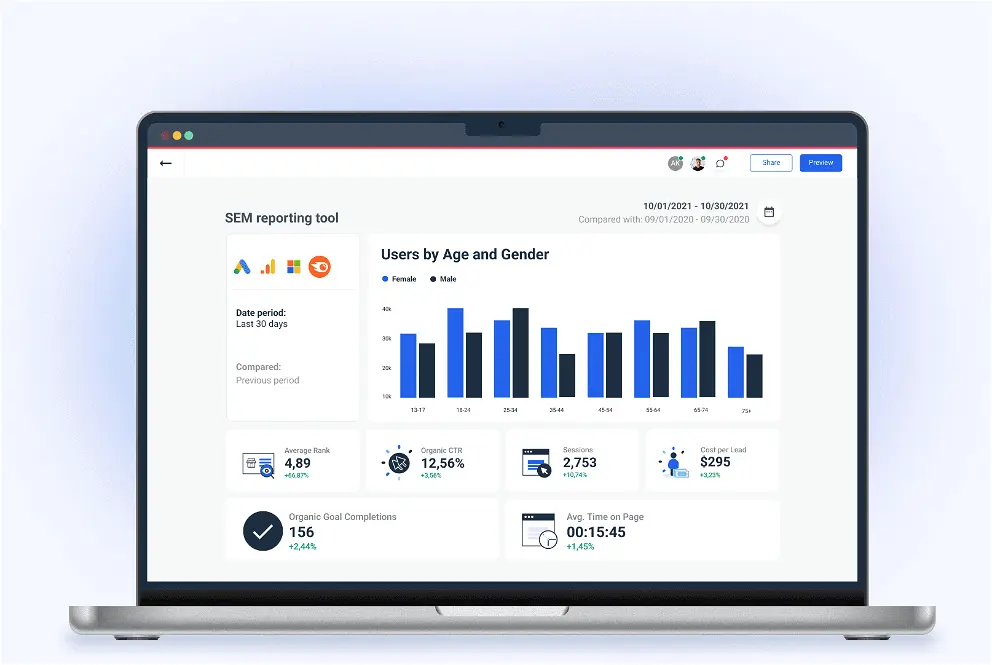In the digital marketing landscape, SEM tools have become indispensable. They are the secret weapons that help businesses thrive in the competitive online space.
But what exactly are SEM tools? They are software solutions designed to streamline and enhance your search engine marketing efforts. They help you manage, optimize, and analyze your paid search campaigns.
The beauty of SEM tools lies in their versatility. They cater to a wide range of tasks, from keyword research and competitor analysis to ad optimization and reporting. This makes them a one-stop solution for all your SEM needs.
The benefits of using SEM tools are manifold. They save time, provide valuable insights, and help you make data-driven decisions. They also scale with your business, supporting your growth every step of the way.
But with so many SEM tools available, both free and paid, choosing the right one can be daunting. It’s crucial to understand their features, benefits, and how they work to make an informed decision.
In this comprehensive guide, we delve into all things SEM tools. Whether you’re a beginner or an experienced marketer, this article will equip you with the knowledge you need to navigate the world of SEM tools confidently.
Understanding SEM and Its Importance
Search Engine Marketing (SEM) is a vital component of digital marketing. It involves promoting websites by increasing their visibility in search engine results pages (SERPs). This is achieved through paid advertising.
Table of Contents
SEM is a broad term that encompasses various techniques. These include Pay-Per-Click (PPC) advertising, Cost-Per-Click (CPC) advertising, and paid search ads. SEM tools are designed to facilitate these techniques, making them more efficient and effective.
What is SEM?
SEM is a strategy used to increase a website’s visibility on search engine results pages. It involves bidding on keywords relevant to the business. When users search for these keywords, the business’s ad appears in the search results.
The goal of SEM is to drive traffic to the website. It’s about getting your ads in front of the right people at the right time. This targeted approach makes SEM a highly effective marketing strategy.

Why is SEM Crucial for Businesses?
In today’s digital age, having an online presence is not enough. With millions of websites vying for attention, standing out in the crowd is a challenge. This is where SEM comes in.
SEM helps businesses reach their target audience in a highly effective way. By appearing in search results for relevant keywords, businesses can attract potential customers who are actively looking for their products or services. This increases the chances of conversions, making SEM a powerful tool for business growth.
The Evolution of SEM Tools
SEM tools have come a long way since their inception. Early tools were basic, offering limited features such as keyword research and bid management. But as the digital marketing landscape evolved, so did SEM tools.
Today’s SEM tools are sophisticated software solutions. They offer a plethora of features, from competitor analysis and ad optimization to comprehensive reporting. They leverage advanced technologies like artificial intelligence and machine learning to provide predictive insights and automate tasks. This evolution has made SEM tools an indispensable part of any successful SEM strategy.
The Anatomy of SEM Tools
SEM tools are complex software solutions designed to streamline and optimize SEM efforts. They are equipped with a range of features that cater to various aspects of SEM, from keyword research and competitor analysis to ad optimization and reporting.
These tools are designed to make SEM more efficient and effective. They automate repetitive tasks, provide valuable insights, and help marketers make data-driven decisions. This makes them an invaluable asset for any business looking to improve its online visibility and reach.
But with so many SEM tools on the market, how do you choose the right one? Consider your specific needs and budget, and look for a tool that offers the features that are most important to you. There are also free and paid SEM tools available, so you can find one that fits your needs.
Key Features of SEM Tools
SEM tools come with a host of features designed to facilitate various aspects of SEM. Some of the key features include:
Types of SEM Tools
There are various types of SEM tools available, each catering to different aspects of SEM.
Keyword research tools, for instance, help identify the most relevant keywords for your business. They provide insights into search volume, competition level, and cost-per-click for each keyword.
Competitive analysis tools allow you to monitor your competitors’ SEM strategies. They provide insights into their keyword usage, ad copy, and landing pages.
Ad optimization tools help improve the performance of your ads. They provide suggestions for ad copy, landing page design, and bid management.
Finally, reporting tools help measure the success of your SEM efforts. They provide comprehensive reports on various metrics, including click-through rate, conversion rate, and return on investment.

How SEM Tools Work: A Technical Perspective
SEM tools work by leveraging advanced algorithms and vast databases of search engine data. They analyze this data to provide insights and recommendations that can help improve your SEM efforts.
These tools are designed to be user-friendly, with intuitive interfaces and easy-to-understand reports. This makes them accessible to marketers of all skill levels, from beginners to seasoned professionals.
Keyword Research and Analysis
Keyword research is a fundamental aspect of SEM. It involves identifying the keywords that your target audience is using to search for products or services like yours.
SEM tools automate this process by providing a list of relevant keywords based on your input. They also provide data on each keyword, such as its search volume, competition level, and cost-per-click. This information can help you choose the most effective keywords for your campaign.
Competitor Analysis and Monitoring
Understanding what your competitors are doing is crucial for staying ahead in the competitive digital landscape. SEM tools provide features that allow you to monitor your competitors’ SEM strategies.
These tools can show you which keywords your competitors are targeting, what their ad copy looks like, and how their landing pages are designed. This information can provide valuable insights that you can use to refine your own SEM strategy.
Ad Optimization and A/B Testing
Ad optimization is another key aspect of SEM. It involves tweaking various elements of your ads to improve their performance.
SEM tools provide suggestions for ad copy, landing page design, and bid management. They also offer A/B testing features, which allow you to test different versions of your ads to see which one performs better.
The Benefits of Using SEM Tools
SEM tools offer a range of benefits that can significantly enhance your search engine marketing efforts. They can save you time, provide valuable data for decision-making, and support your business’s growth.
Efficiency and Time-Saving
One of the main advantages of SEM tools is their ability to automate repetitive tasks. This includes keyword research, competitor analysis, and ad optimization. By automating these tasks, SEM tools can save you a significant amount of time.
This time-saving aspect allows you to focus on more strategic aspects of your SEM campaigns. It also reduces the risk of human error, ensuring that your campaigns are as effective as possible.
The time saved by automating tasks like keyword research and competitor analysis translates to increased productivity for SEM professionals. This allows them to:
Data-Driven Decision Making
SEM tools provide a wealth of data that can inform your marketing decisions. This includes data on keyword performance, competitor strategies, and ad effectiveness.
By analyzing this data, you can make informed decisions about which keywords to target, how to design your ads, and where to allocate your budget. This data-driven approach can significantly improve the performance of your SEM campaigns.
Scalability and Growth
As your business grows, your SEM needs will likely grow as well. SEM tools are designed to scale with your business, allowing you to manage larger campaigns and more keywords as your needs evolve.
This scalability can be a significant advantage for growing businesses. It ensures that your SEM efforts can keep pace with your business growth, helping you to reach a larger audience and achieve your marketing goals.
Free vs. Paid SEM Tools: Making the Right Choice
Choosing between free and paid SEM tools can be a challenging decision. Both options have their advantages and trade-offs. Your choice will depend on your specific needs, budget, and marketing goals.
Advantages of Free SEM Tools
Free SEM tools can be a great starting point, especially for small businesses or individuals with limited budgets. They offer basic features that can help you get started with SEM, such as keyword research and competitor analysis.
However, free tools often have limitations. They may not offer the same level of data analysis, automation, or customer support as paid tools. But they can provide valuable insights and help you understand the basics of SEM.
When to Invest in Paid SEM Tools
Paid SEM tools are a worthwhile investment when you’re ready to take your SEM efforts to the next level. They offer advanced features, such as automated ad optimization, detailed reporting, and predictive analytics.
These tools can provide more in-depth insights, save you more time, and help you manage larger campaigns. If you have the budget and need these advanced features, investing in a paid SEM tool can be a smart decision.
How to Decide Which SEM Tools Are Best for Your Business
Choosing the right SEM tool for your business depends on several factors. These include your budget, your specific SEM needs, and the size and complexity of your campaigns.
Consider what features are most important to you. Do you need detailed reporting, automated ad optimization, or competitor analysis? Also, consider the tool’s ease of use, customer support, and integration with other marketing platforms. By considering these factors, you can choose an SEM tool that best fits your business needs.
SEM Reporting Tools: Tracking Success and ROI
SEM reporting tools are crucial for measuring the success of your campaigns. They provide valuable insights into your campaign performance and return on investment (ROI). These tools can help you make data-driven decisions and optimize your SEM strategies.
Search Engine Marketing (SEM) relies heavily on data analysis to optimize campaigns and maximize ROI. Reporting tools are essential for gathering, organizing, and interpreting this data. Here are 5 of the best-known and widely used SEM reporting tools:
1. Google Ads (Built-in Reporting):
- Description: Since Google Ads is the dominant platform for paid search, its built-in reporting is a crucial starting point. It provides a wealth of data on campaigns, ad groups, keywords, and individual ads.
- Key Features:
- Pre-built reports: Offer quick insights into performance.
- Customizable dashboards: This allows you to track specific metrics relevant to your goals.
- Segmentation and filtering: Enable you to drill down into the data and analyze performance based on various dimensions (e.g., device, location, time of day).
- Conversion tracking: Measures the effectiveness of your campaigns in driving desired actions (e.g., sales, leads, website visits).
- Attribution modeling: Helps understand how different touchpoints contribute to conversions.
- Why it’s essential: It’s the primary source of truth for your Google Ads campaigns, providing the most granular and accurate data.
2. Google Analytics:
- Description: While not strictly an SEM tool, Google Analytics is indispensable for understanding how users interact with your website after they click on your ads. It connects the dots between ad clicks and website behavior.
- Key Features:
- Website traffic analysis: Shows how users arrive at your site (including from Google Ads), what pages they visit, and how long they stay.
- Audience demographics and interests: Provides insights into your website visitors.
- Conversion tracking (Goals and E-commerce tracking): Tracks user actions on your website, allowing you to measure the ROI of your SEM campaigns.
- Behavior flow reports: Visualizes the user journey through your website.
- Why it’s essential: It provides crucial context for your SEM data, showing how your ads are driving valuable actions on your website.
3. SEMrush:
- Description: SEMrush is a comprehensive suite of SEO and SEM tools, offering robust reporting features for both paid and organic search.
- Key Features:
- Keyword research and tracking: Helps identify relevant keywords and track their rankings.
- Competitor analysis: Allows you to analyze your competitors’ keywords, ad strategies, and website traffic.
- Site audit: Identifies technical SEO issues that may be affecting your website’s performance.
- Advertising research: Provides insights into your competitors’ ad copy, landing pages, and budgets.
- Reporting dashboards: Offer customizable reports on various metrics.
- Why it’s essential: SEMrush provides valuable competitive intelligence and helps you identify opportunities to improve your SEM campaigns.
4. Ahrefs:
- Description: Similar to SEMrush, Ahrefs is a powerful SEO and SEM toolset with strong reporting capabilities. It is particularly known for its backlink analysis features.
- Key Features:
- Keyword research and tracking: Helps find relevant keywords and track their performance.
- Competitor analysis: Allows you to analyze your competitors’ backlinks, keywords, and content.
- Site audit: Identifies SEO issues on your website.
- Rank tracking: Monitors your website’s rankings in search results.
- Reporting dashboards: Offer customizable reports on various metrics.
- Why it’s essential: Ahrefs excels at competitive analysis and provides valuable insights into your competitors’ SEO and SEM strategies.
5. Supermetrics:
- Description: Supermetrics is a data integration tool that allows you to pull data from various marketing platforms (including Google Ads, Google Analytics, Facebook Ads, and more) into a single platform like Google Sheets, Google Data Studio (Looker Studio), or Excel.
- Key Features:
- Data connectors: Connects to a wide range of marketing platforms.
- Automated reporting: Automates the process of pulling and combining data from different sources.
- Customizable dashboards and reports: Allows you to create custom reports and dashboards to track key metrics.
- Why it’s essential: Supermetrics saves time and effort by automating data collection and allows you to create comprehensive reports that combine data from multiple sources. This is especially useful for agencies or marketers managing multiple campaigns across different platforms.
Key Reporting Features to Look For
When choosing an SEM reporting tool, there are several key features to look for. These include real-time data analysis, customizable dashboards, and historical data analysis. These features can provide you with a comprehensive view of your campaign performance.
Additionally, look for tools that offer predictive insights. These can help you forecast future trends and make informed decisions about your SEM strategies.
Real-Time Data and Customizable Dashboards
Real-time data is crucial for tracking the performance of your campaigns. It allows you to monitor your ads’ performance and make immediate adjustments if necessary. Customizable dashboards, on the other hand, let you focus on the metrics that matter most to your business.
These dashboards should be user-friendly and provide clear, actionable insights. They should allow you to easily track your key performance indicators (KPIs) and visualize your campaign data.
Historical Data Analysis and Predictive Insights
Historical data analysis is another important feature of SEM reporting tools. It allows you to analyze past campaign data and identify trends and patterns. This can help you predict future performance and make strategic decisions.

Predictive insights, on the other hand, use machine learning algorithms to forecast future trends. These insights can help you optimize your bids, improve your ad copy, and better target your audience. By leveraging these features, you can maximize the effectiveness of your SEM campaigns.
How do I start SEM?
To start with Search Engine Marketing (SEM), you can follow these steps:
1. Set Clear Goals: Define what you want to achieve with your SEM campaigns, whether it’s increasing website traffic, generating leads, or boosting sales.
2. Keyword Research: Conduct thorough keyword research to identify relevant keywords for your ads. Use tools like Google Keyword Planner or SEMrush for this purpose.
3. Create Compelling Ad Copy: Write engaging ad copy that includes your chosen keywords and entices users to click on your ads.
4. Set Up Campaigns: Use platforms like Google Ads to create your SEM campaigns. Define your target audience, set your budget, and choose where and when your ads will appear.
5. Monitor and Optimize: Regularly monitor the performance of your campaigns. Analyze data such as click-through rates, conversion rates, and ROI. Make adjustments to optimize your campaigns for better results.
By following these steps, you can start your SEM journey effectively and work towards achieving your marketing goals.
Conclusion: Maximizing SEM Tool Effectiveness
In conclusion, SEM tools are a vital asset for any digital marketer. They offer a range of features that can streamline your SEM efforts, provide valuable insights, and ultimately, improve your campaign performance.
Best Practices for SEM Tool Usage
To maximize the effectiveness of your SEM tools, it’s important to use them strategically. This includes regularly monitoring your campaign performance, making data-driven decisions, and continuously optimizing your strategies based on the insights provided by the tools.
Staying Ahead with SEM Tools: Future Trends
As the digital marketing landscape continues to evolve, so too will SEM tools. Staying updated with the latest tool advancements and industry trends is crucial for maintaining a competitive edge in the ever-changing world of search engine marketing.
Is SEM more expensive than SEO?
Yes, SEM is generally more expensive than SEO. This is because with SEM, you directly pay for each click on your ad, while SEO focuses on organic ranking which doesn't involve upfront costs.
Can SEM improve SEO?
SEM can indirectly improve SEO. While they're separate strategies, they can work together:
Brand awareness: SEM ads can increase brand awareness, potentially leading to more organic clicks.
Keyword insights: SEM data can reveal valuable keywords for SEO efforts.
Landing page testing: SEM allows testing landing pages to optimize for conversions, which can benefit SEO indirectly.
However, SEM itself doesn't directly influence search engine algorithms for organic ranking.
Is Google ads the same as SEM?
Google Ads is a popular platform for SEM, but not the only one. SEM (Search Engine Marketing) is a broader concept encompassing all paid advertising strategies to increase website visibility in search results.
Here's the breakdown:
SEM (Search Engine Marketing): The overall strategy of using paid and unpaid methods to improve search engine visibility.
Google Ads: A specific platform offered by Google for creating and managing paid search ads.
Think of SEM as the umbrella term and Google Ads as one of the tools you can use under that umbrella.
Is Facebook ads a SEM?
No, Facebook Ads is not considered SEM (Search Engine Marketing). Here's why:
Focus: SEM specifically targets users actively searching for information or products on search engines. Facebook Ads targets users based on demographics, interests, and behaviors on the Facebook platform itself, not their search queries.
Platform: SEM focuses on search engine results pages (SERPs) like Google or Bing. Facebook Ads leverages the Facebook platform for ad placement.
SEM and Facebook Ads are both digital marketing strategies, but they target users at different stages of the buying journey. SEM reaches users with purchase intent, while Facebook Ads can be used for brand awareness, lead generation, and various other marketing goals.
What is Google PPC vs SEM?
SEM (Search Engine Marketing) is the bigger picture, encompassing both paid and unpaid strategies to improve your search engine visibility. PPC (Pay-Per-Click) is a specific type of paid advertising that falls under the SEM umbrella.
Here's the breakdown:
SEM (Search Engine Marketing): This involves optimizing your website and content to rank higher organically in search results (SEO) as well as using paid advertising platforms like Google Ads to appear at the top of search results.
Google PPC (Pay-Per-Click): This is a specific advertising model where you pay Google each time someone clicks on your ad displayed on search engine results pages (SERPs).
In simpler terms:
SEM: Getting noticed in search engines for free (organically) and through paid ads.
Google PPC: Just one specific type of paid ad you can use within your overall SEM strategy.
